The second quarter of 2019 saw the average price of ads in Facebook’s services dropping by 4%. During the same period, ad impressions went up by 33%, largely due to ads on Facebook News Feed, Instagram Stories, and Instagram Feed.
These developments are good news for businesses and advertisers, especially those looking to expand their market by tapping the company’s billions of users on multiple platforms.
This article digs deeper into why businesses–including startups, small business owners, freelancers, and agencies–must include Facebook in their marketing strategies. It will also touch on some reasons why Facebook ads fail to convert users, what you can do to avoid these pitfalls, and a few examples of businesses who nailed their ads.
I. Why Facebook Ads Must Be Part of Your Marketing Strategy
As of the third quarter of 2019, Facebook had 2.45 billion active users. According to Statista, Facebook was also the first social media to reach 1 billion users, which it achieved in 2012. Aside from its huge user database, here are a few more figures to inspire you to create an effective Facebook marketing strategy.
• As of October 2019, India had the highest number of Facebook users (269 million), followed by the U.S. (183 million).
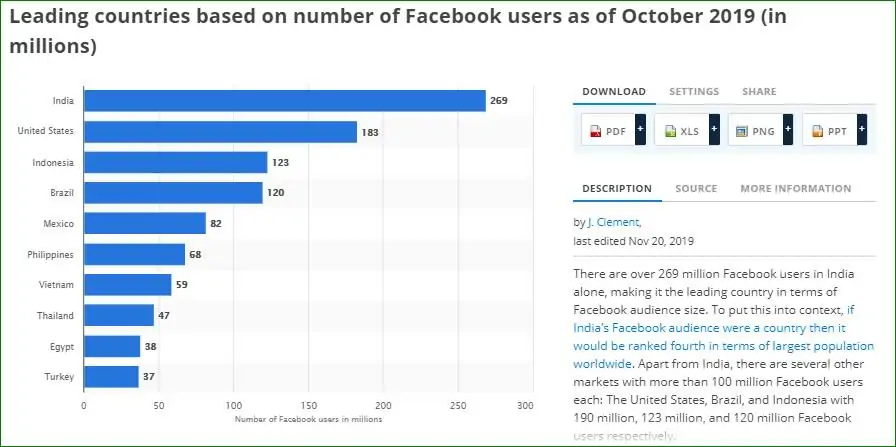
• Across different age groups, more than 50% of U.S. adults use Facebook. Meanwhile, 41% of those aged 65 and above are also on the platform.
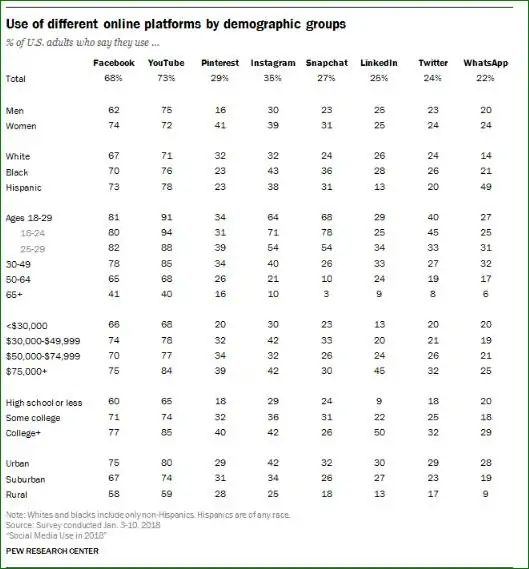
• As of the first quarter of 2019, Facebook fueled 80.4% of U.S. social referrals to ecommerce sites.
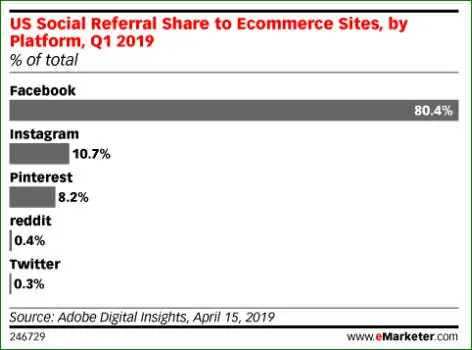
• Each month, average Facebook users click 11 ads, with women clicking on more ads than men do (14 and 10 ads, respectively).
• Mobile advertising made up the bulk (about 94%) of Facebook’s advertising revenue in the second quarter of 2019.
II. 5 Reasons Facebook Ads Fail to Convert
Facebook offers so many ways for you to reach your target audience. But in order to actually appeal to those users’ interests, there are a few things you need to do and mistakes to avoid. Remember that Facebook offers you the platform and the tools, but the strategy for a successful campaign lies with you.
1. You chose the wrong objective
When you create a Facebook ad, you will be asked about your objective, i.e., how you want to grow your business. Each option leads a specific pre-set information you need to fill in or choose from. If you choose the wrong objective, you will not get the results you’re targeting.
For example, if you want to promote your website, you can choose several actions such as “Apply Now,” “Book Now,” “Contact Us,” “Download,” “See Menu,” Shop Now,” “Request Time,” and “Sign Up.”
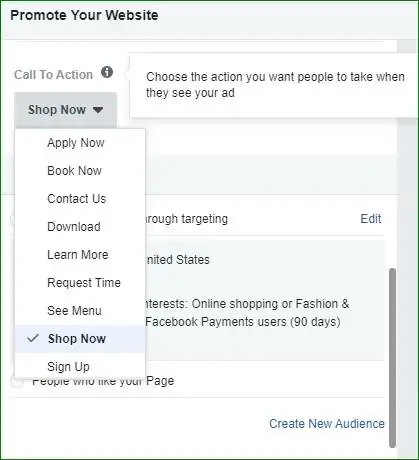
But if you want to create a form to generate leads, you won’t have the other CTA options. Instead, you have the option to customize the form and ask for customer details that will be useful for your campaign.
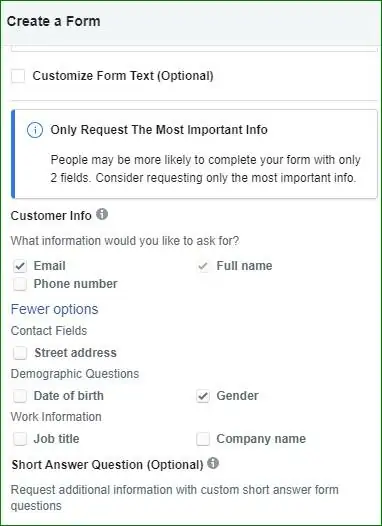
2. You’re not targeting your audiences properly
There are two ways you will be charged for running Facebook ads: cost per thousand impressions and cost per click. To get the most out of your money and campaign, you’d want to make sure your ads are being shown to the right people. Otherwise, you’ll be paying for impressions or clicks from individuals who are outside your target demographic.
Plus, you want to make sure your target audiences are not too broad, as doing so would run the risk of showing it to a lot of uninterested users. But neither should it be too narrow that it can only be seen by very few people, resulting in generating very little interest.
3. Your ad copy isn’t appealing to your target audience
Your target users are more likely to click on your ad when:
• It succinctly captures their pains, fears, challenges, and hopes, and you try to offer a solution.
• Users feel they will benefit from following through with your call-to-action (CTA)–whether through learning something, getting limited-time offers, or finding a solution to their problem.
When creating and revising your copy, ensure that these are powerful enough to capture your targets’ needs or to express some benefits. You would also benefit from making it conversational, so readers feel like the ad or video is connecting with them on a personal level. Use “you” instead of “we/us.” Then, create CTAs or offers that will “entice” them to act and click on your ad or fill up a form now.
4. Your ads fail to grab users’ attention or curiosity
When you come across an ad on Facebook, what’s the first thing that grabs your attention? Is it the persuasive copy? A powerful image? A short, impressive video that makes you want to know more?
Visuals can have a huge impact on your campaign. So if your ads are performing poorly, i.e., they are below the average CTR on Facebook of 0.9%, then you might want to experiment with different ad formats or other images.
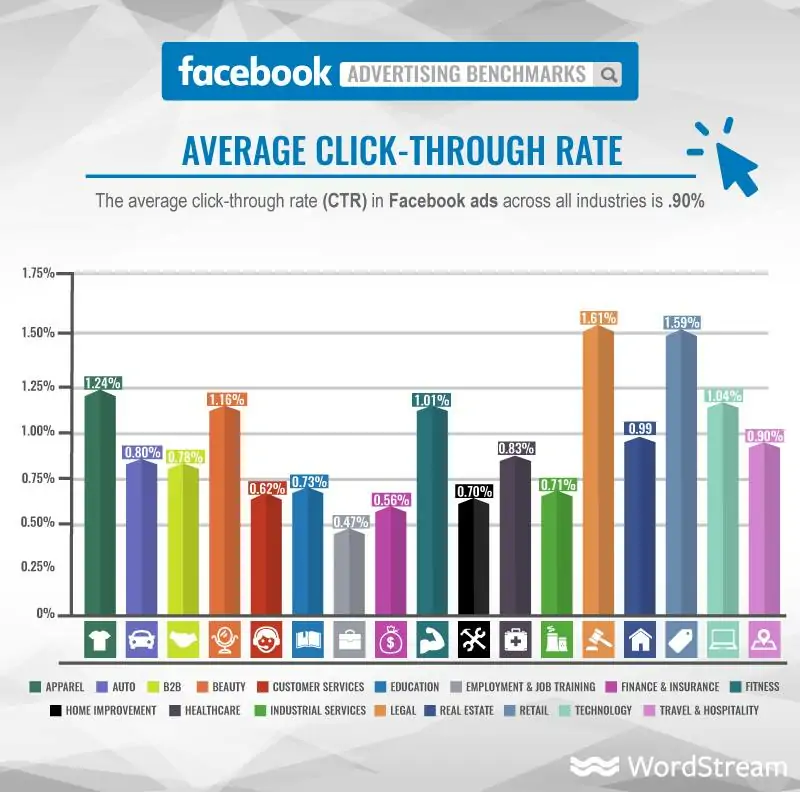
5. You’re not retargeting users who have engaged with your ad, Facebook page, or website
Many users won’t buy or subscribe the first time they click on your ad. They may watch your video, click on an image, or go as far as adding items to their cart… then they close your page.
Through retargeting or remarketing ads, you can try to reach out again to these individuals who have engaged with your ad or shown some interest in your business. By doing this, you allow users to get to know your brand better and put it top-of-mind, or you continue to fuel their desire or interest in your offer. So if you are not retargeting them at all, then you are missing out on a huge opportunity to convert.
III. How to Create Facebook Ads That Convert
A successful ad campaign does not begin with creating the ads, nor does it end with running the campaign. It begins with having a clear objective, involves experimentation, and a willingness to keep improving until you find an ad that works for your target audience and objective. Here are some of the steps you need to take to increase your team’s chances of improving your ad campaign’s results.
1. Get Clear on Your Marketing Objective
Why is this important?
Being clear about your marketing objective is the first step in creating an effective ad campaign. When you know what your main objective is, you can:
• Clarify what types of audiences you are targeting
• What lead magnet to use
• How to write your ad copy
• What type of Facebook ad to use
Before you create an ad, Facebook Ads Manager will ask you to choose your objective.
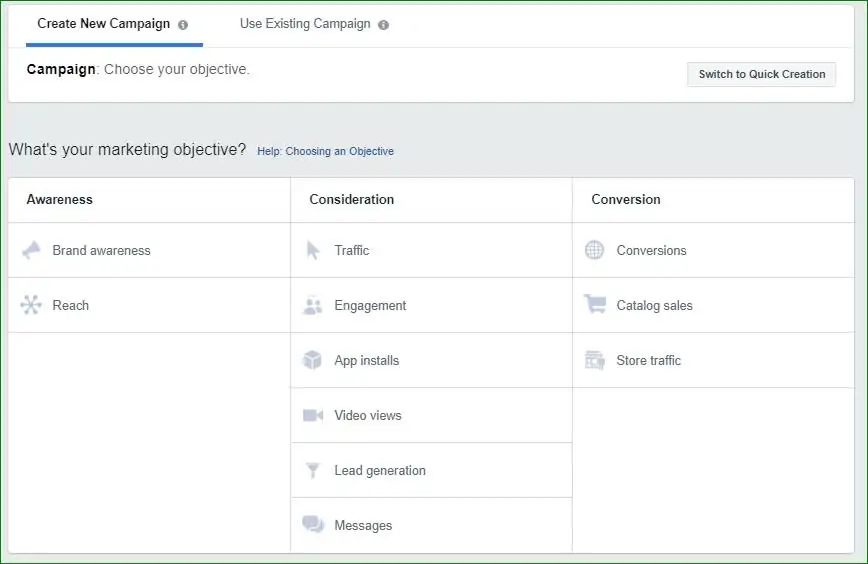
Each Facebook ads objective is further classified into more specific goals:
• Awareness: Choose this objective if your main goal for the ad is to reach more people, generate new leads, or you want to introduce your product or service. These are ads focused on leading people to the top of your funnel. You can further choose between two options: brand awareness ads and reach ads.
• Consideration: Opt for this objective if you want to increase engagement with your target audience. These interactions can be through traffic, app installs, engagement (boosting posts, getting more Page likes), and lead generation (i.e., collecting interested Facebook users’ information), among others.
• Conversion: Select this if your main goal is to get people to buy your product or service. You can direct users to a separate page to register to your course or buy your book. You can show them selected products from your catalog, or even encourage people near your physical store to drop by.
2. Improve Targeting by Creating Custom Audiences and Adding a Facebook Pixel
If you want to get the best bang for your buck, zero in on your target audience. This way, you don’t waste time (creating a superb ad) and money (for click or impressions) on users who are outside your target market due to their location, language, age, interests, or other factors.
To ensure your ads will be shown to the right groups, you need to create a custom audience.
In your Facebook Ads Manager, click Settings on the upper left, move to the Assets column, and select Audiences.
In the next window, click the drop down menu beside Create Audience and choose Custom Audience.
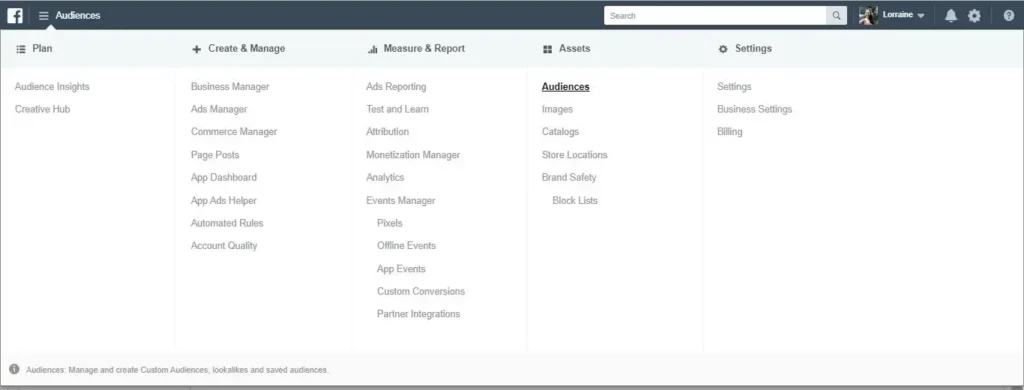
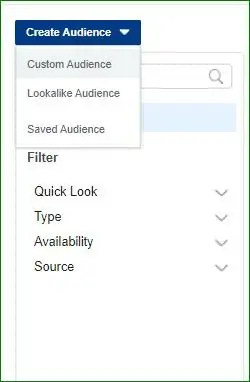
The next window offers you several ways to create custom audiences.
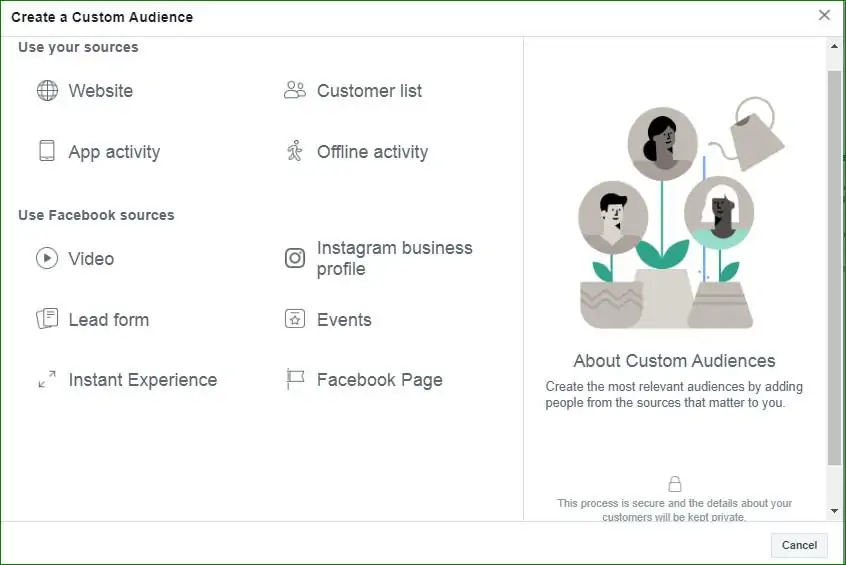
You can choose from among Facebook sources if you want to select the audiences for your:
• Videos – those who watched your Facebook or Instagram videos.
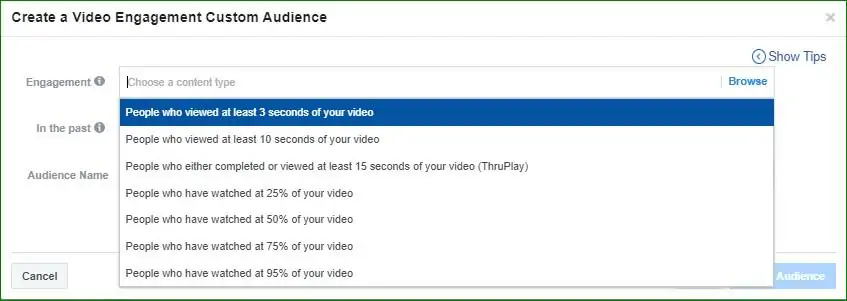
• Lead form – those who filled out a form on your lead generation ads.
• Instant Experience – those who interacted with your instant experience on either platforms.
• Instagram business profile – those who engaged with your Instagram profile or ad.
• Events – those who interacted with your Facebook events.
• Facebook page – those who engaged with your page.
Aside from Facebook sources, you can use other data you may have, such as:
• App activity – those who used your app.
• Customer list – your own customer list.
• Offline activity – Those who interacted with your business offline, such as through your brick-and-mortar store, over the phone, and live events. For this option, you need to create a Business Manager account and create an offline event set.
• Website – those who visited your site. You need to install a Facebook pixel to gather data on your users’ actions. Some examples of data you can collect if you install a Facebook pixel include users who purchase on your site, added items to their cart or to their wishlist, abandoned their cart, signed up for a course, or subscribed to your mailing list. You can use these details during retargeting campaigns, creating lookalike audiences, or in improving your ad campaign results.
Here’s how you can install a Facebook pixel on your website.
If you have a Business Manager or Ads Manager account, proceed to the Measure & Report column and select Pixels.
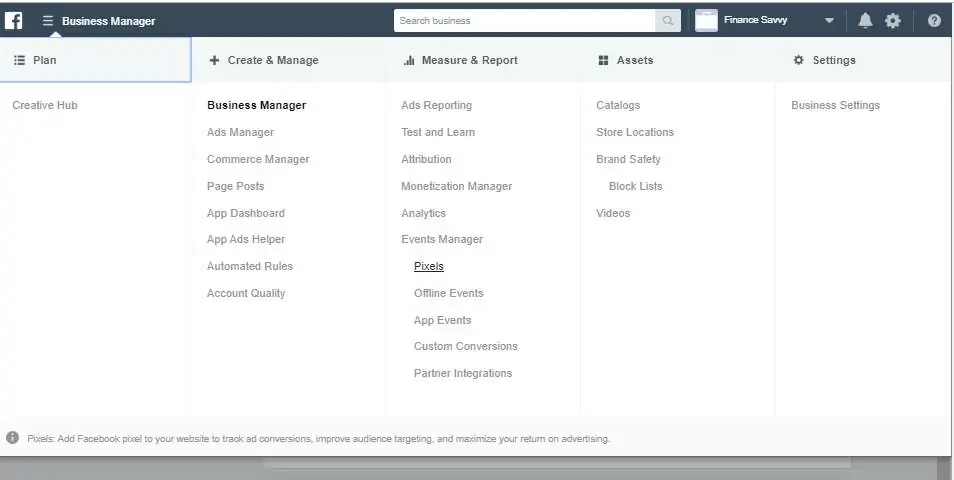
Click Create a Pixel.
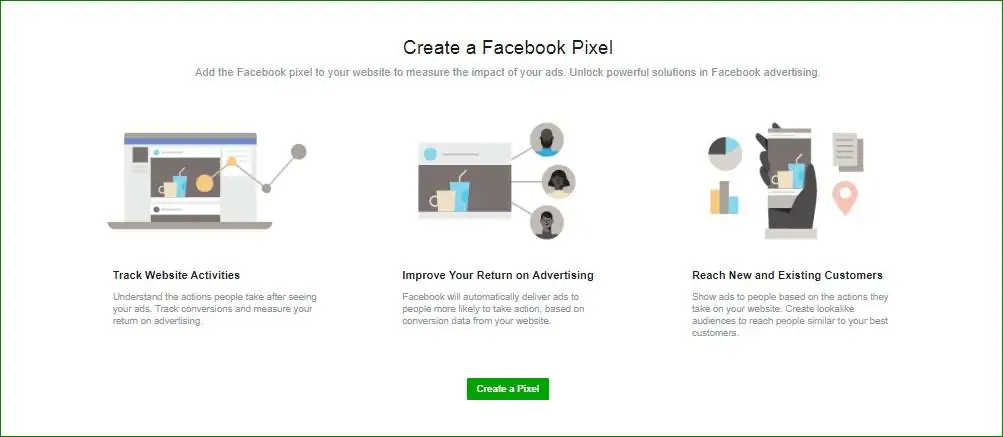
Then, fill in with your pixel name and website URL. In the next window, choose how you wish to install the pixel code, and follow Facebook’s instructions for finishing the installation.
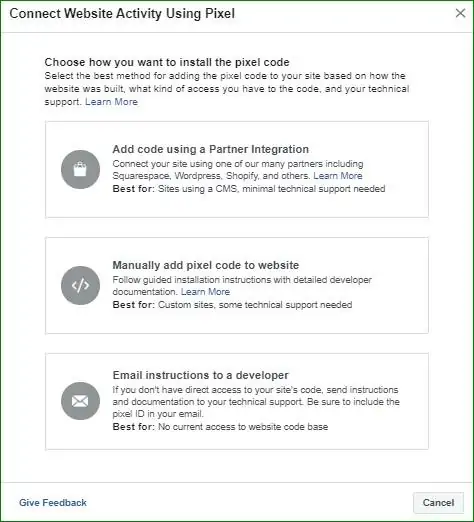
Once you have these audiences, you can start using these during your ad campaign, or you can create an entirely new audience. For example, after creating your objective and budget, you can choose a custom audience (if you want to use one), or create a new audience by specifying your target users’ location, age, gender, or languages.
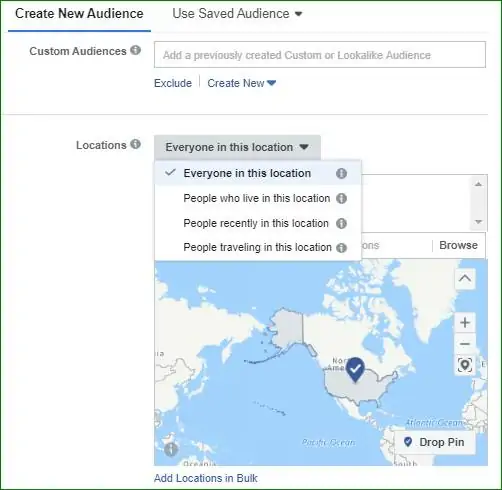
You can also include or exclude users based on factors like demographics (ex., job title, education), interests, behaviors, and connections.
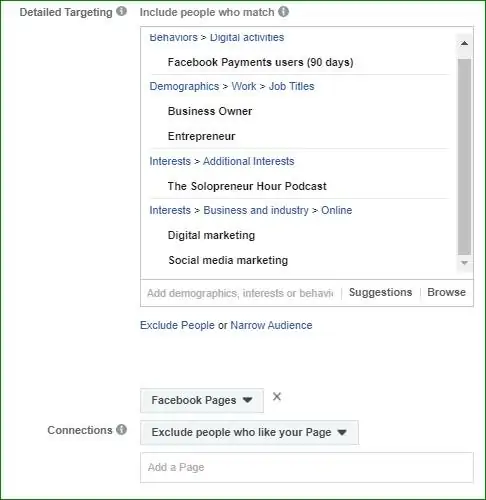
This infographic by WordStream perfectly illustrates all the ad targeting options at your fingertips.

To help you analyze your campaign results later on, be sure to have each interest group as a separate custom audience.
3. Create an Irresistible Lead Magnet
Your users value their personal information. And if you want them to give you their details, even just their email address, which you can add to your drip campaigns, you must offer something valuable in exchange. This is where lead magnets come in.
A lead magnet is an offer you provide users in exchange for information, such as their names, email address, company/business, and contact details. Equally important, it’s one way to provide value to your target audience, helping you build trust and rapport while positioning yourself as an expert in your field.
Lead magnets can take a lot of forms, such as:
• Checklists, Guides, Workbooks, Templates
• Webinars, Video Trainings, Online Classes
• Case Studies
• Reports
• Discount Codes, Free Shipping
• Quiz Results
• Email Courses
To be able to persuade Facebook users to give you their information, your offer needs to be compelling enough, something that they feel or know they truly need and may not easily get elsewhere. If you need ideas for lead magnets, you can browse comments or questions visitors leave on your page, website, or other platforms.
Once they give you their details, deliver your promised offer promptly. Moreover, ensure that your lead magnet is of high quality. Remember that you want to make a good impression with your newly acquired leads, even if they are not yet ready to purchase your product or service. If you serve them something poorly written or made, they may feel scammed and quickly unsubscribe from your list.
4. Create a Facebook Business Manager Account
As your business grows, you may hire other individuals or companies to help you run, analyze, or tweak your campaigns. To enable them to do these without giving them access to your personal Facebook accounts, you can create a Facebook Business Manager Account.
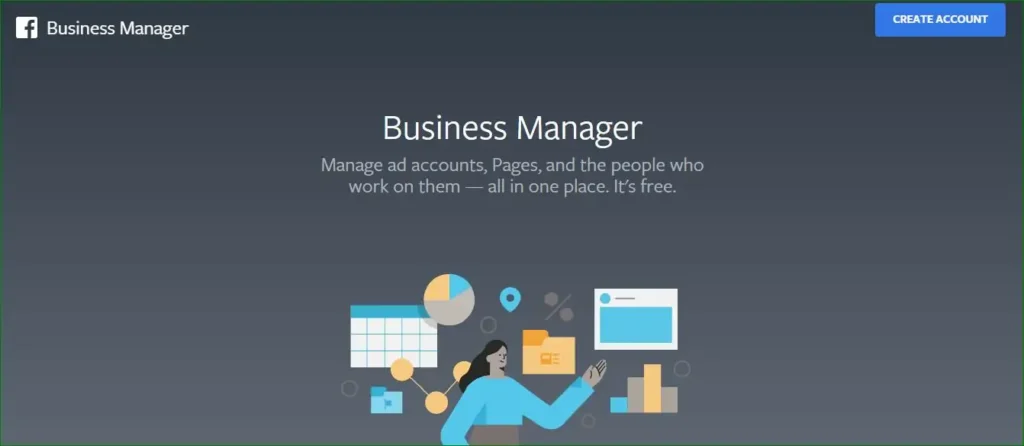
Business Manager lets you run separate ad accounts and use different payment methods for each of your client or business. If you are running marketing teams, you can grant them role-specific access to business pages and ad accounts. It helps you stay on top of things, as you can easily track who is doing which tasks. Lastly, it gives you peace of mind. You don’t have to worry about granting others access to your/your client’s personal Facebook account, or giving them access to information and accounts beyond what their roles require of them.
To create an account, go to Facebook Business Manager and click Create Account. In the next window, type your business name, your name, and your business email.
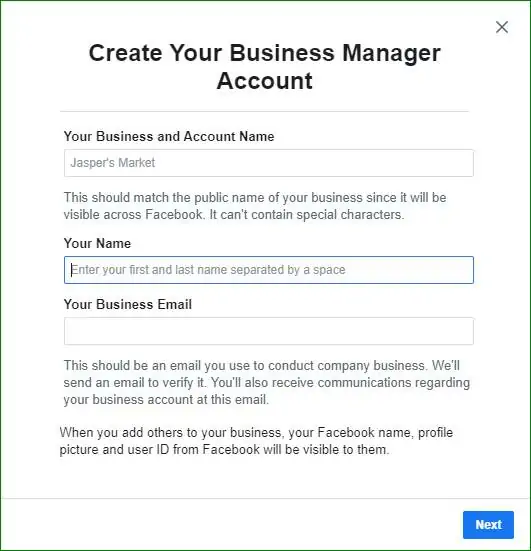
In the next window, provide your business details, then confirm your email address. After this, go you Business Settings so you can:
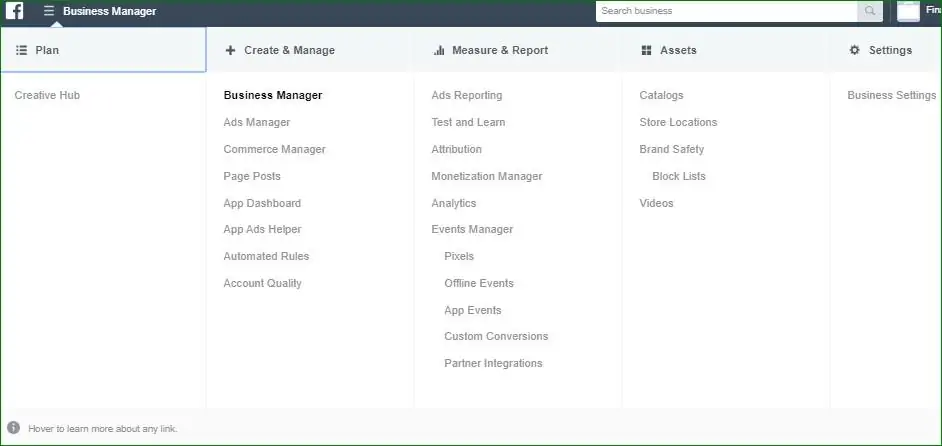

✔ Start adding partners to share assets with or request assets from

✔ Adding your pages
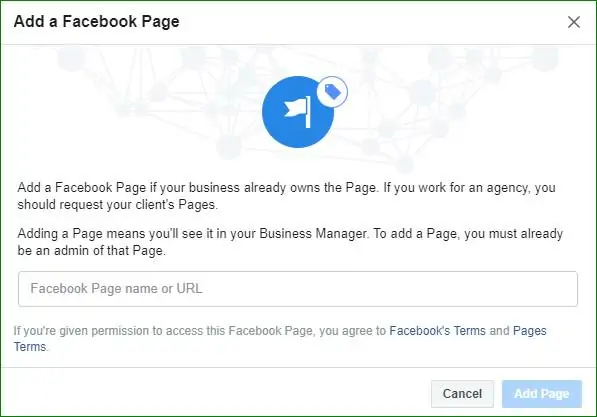
✔ Adding ad accounts
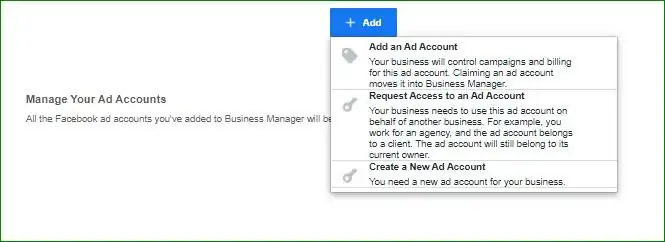
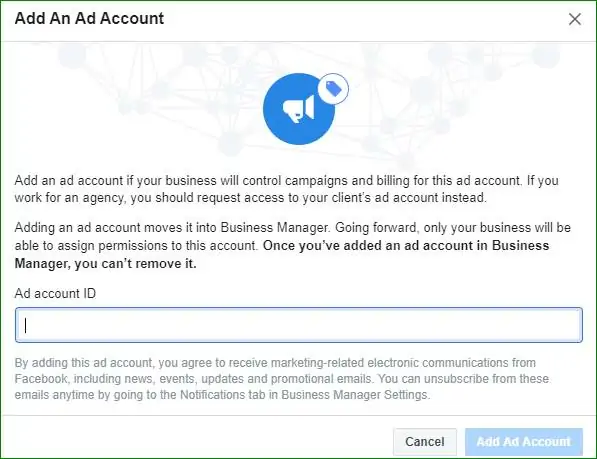
✔ Providing other information such as:
• Apps
• Instagram Accounts
• Data sources (catalogs, pixels, offline event sets, custom conversions, event source groups, shared audiences)
• Domains
5. Streamline Your Ad Copy and Visuals
A great visual–whether an image or a video–can go a long way in helping increase users’ interest and engagements with your ad campaign. These can grab their attention, help them quickly grasp your offer, and tap into their emotions.
When choosing an image or creating a video script, ask yourself:
• Does this match or complement my ad copy?
• Does it add value by helping me say or convey what I can no longer include in my short ad copy?
• Does it help my target audience easily grasp what my ad is all about?
• Does it catch my target users’ attention, enough to make them stop their infinite scroll?
• Does it match my landing page?
But even before you ensure that your visual and ad copy complement each other, you need to first ensure your ad copy speaks to the pains, problems, needs, desires, dreams, or interests of your custom audiences.
Also, if you have several target audiences or buyer personas, create a different ad copy and visual for each one. For example, you can use one ad for entrepreneurs based in the U.S., and then another to target Latin America-based clients. If you are offering language as well as programming courses, you may need to use different images and ad copy for each, as these products will appeal to different individuals.
When you opt for video ads, be sure to include subtitles. This is to help target users easily follow and understand your ad’s contents, especially since 85% of Facebook videos “are watched without sound.”
Lastly, avoid including too many image texts, i.e., words embedded in the photo itself. According to Facebook, photos which have less than 20% text perform better.
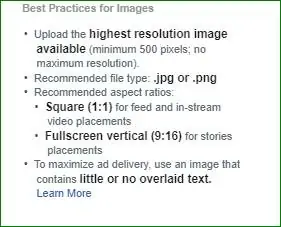
Facebook offers a free image text check tool to help advertisers determine if there’s too much text on their ad. The platform does offer exceptions such as images of book and album covers, products, games, and posters. If your selected image doesn’t fall within these exceptions, eliminate texts on your ad image and incorporate the text in your copy instead.
6. Experiment with Facebook Ad Formats
There are many ways you can use images and videos in your ads. Here are a few.
• Photo ads – These are easier to do and a powerful image, combined with concise copy, is enough to get a user to click on your ad.
• Video ads – These supplement your body text or ad copy. Video ads allow you to say more in less time and communicate with your audience through words as well as visuals.
• Carousel ads – These let you display several products, different features, or multiple items in a collection.
• Slideshow ads – These light-weight ads let you merge sound, text, visual, and movement to capture audiences’ attention.
7. Create an Effective Landing Page That is Laser-Focused on Conversion
Have you ever clicked on an ad you found interesting, then you were led to the advertiser’s home page? And from there, you just began to wander around, trying to figure out what to do next (or if you want to even do anything)? Or maybe, the sheer number of buttons you can click on quickly turned your interest into confusion, prompting you to leave the page immediately?
The same thing happens to many Facebook users who, after clicking your ad, is led to your home page with its multiple navigation options. They get confused, and leave. And you, the advertiser, just lost money and a prospective lead too.
This is why Facebook advertisers opt to have dedicated landing pages for their campaigns. These landing pages have a single purpose (conversion) tightly linked with their marketing objective.
Advertisers who create successful campaigns know how important it is to provide users with a seamless experience. So they match the ad–from the copy to the visuals–with the landing page. They put key points in their ad, then provide other relevant information within their landing page.
For example, if you are launching a new course, you create an ad that appeals to your target audience’s needs and a glimpse of a solution and how much it will cost them. Then in your landing page, you take your audience through more details on how your new course can help them. Then, you include more information about the lecturer plus some social proof. This social proof can take the form of client logos, client testimonials, or recommendations from influencers or respected professionals in your field. You can even add the regular price of the course, then its discounted cost if they register now, so users can further appreciate the value of your offer.
To keep users focused on your campaign goal, you need to minimize or eliminate navigation options on your landing page. Basically, the biggest, most visible button users must find on your landing page is your call-to-action (CTA).
If your goal is to get them to sign up for your course, use an appropriate CTA. Don’t present other options within your landing page, such as exploring other courses, watching other videos, reading your blog articles—these are pulling them away from your desired action (i.e., to sign up).
Also, try to experiment with different CTAs so you know which wordings or colors work better. For example, in a test done by HubSpot, they found that using the words “Click Here” or “Go” in the CTA generates higher conversions than using “Submit,” Download,” or “Register.”
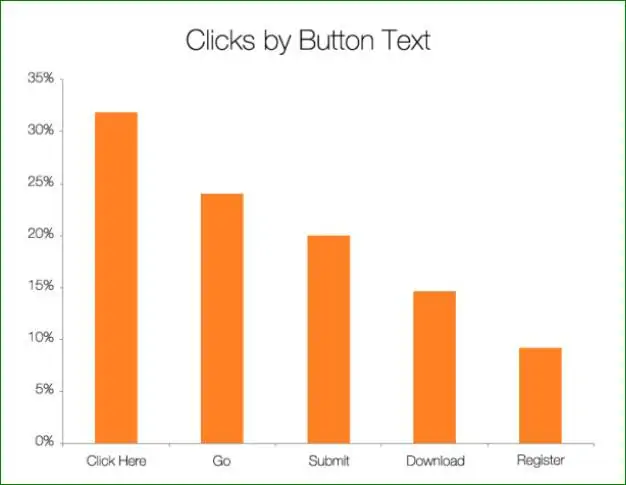
Likewise, minimize the amount of information you ask from your target users. For example, do you really need to know their age or company then and there? By providing only a few fields (ex., asking just for their email address or first name and email) users are more likely to proceed with the conversion. They don’t feel that you are asking for too much details. and this puts them at ease. Once they’re in your mailing list, you can start continuing to build rapport and trust before asking them for more information or to avail of a product or service from you.
8. Split Test and Analyze the Results
Marketing experts don’t get everything right the first time. They experiment through split testing until they find what works for their campaign or target audience.
There are several ways to test your ad or ad set. For example, you can change the copy while using the same visuals. Or you can change the visuals while using the same copy. Aside from these, you can experiment with different audiences or the placement of your ads.
Facebook lets you carry out split tests through guided creation, duplication, and quick creation.
For guided creation, start by choosing your marketing objective and in the next window, clicking the Split Test toggle.
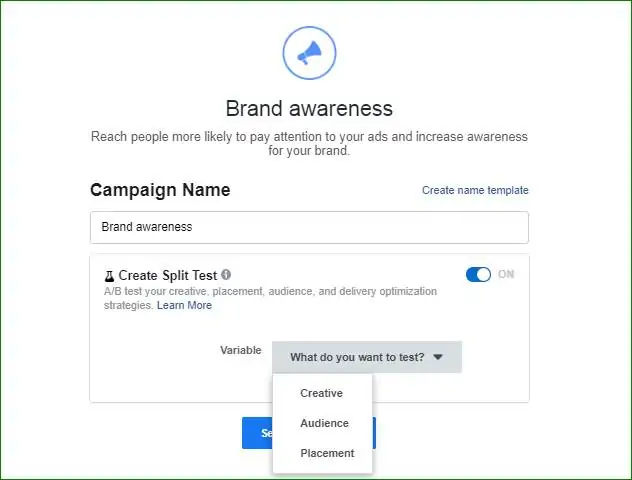
In the next window, fill in the details for your ad audience, placement, and deliver optimization. At the bottom of the page, input your split test budget, desired schedule, and duration.
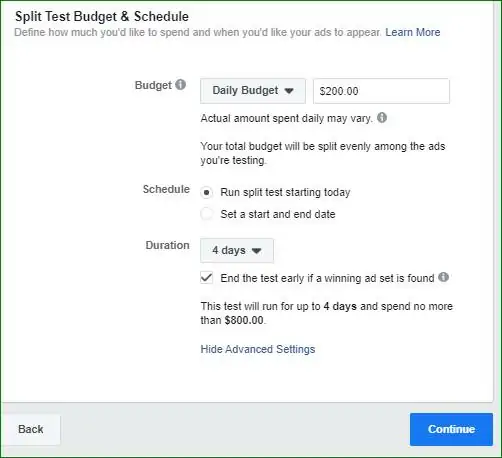
If you are using Quick Creation, just select the campaign objective, click the Split Test toggle, and select the variable you want to test. You can use this option to experiment with audience, placement, delivery, creatives, product sets, and the effects of edits you make on active ad sets.
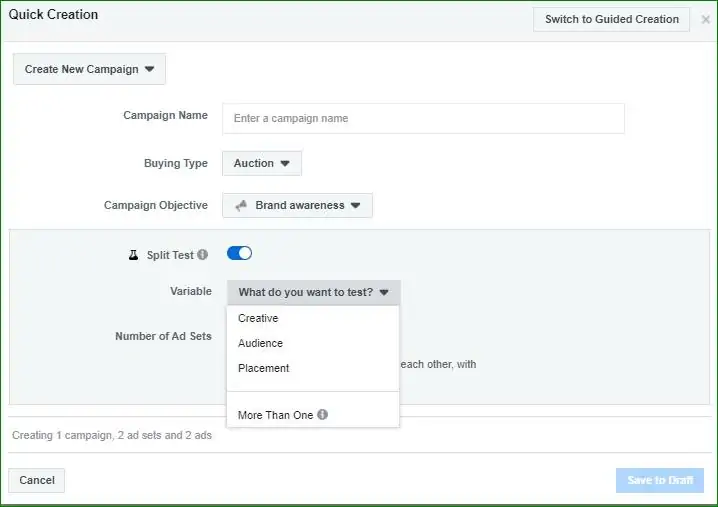
If you want to compare an original ad set with a new ad set, you can use the Duplicate Ad Set option. You can also view more detailed instructions on Facebook.
Then let your campaign or tests run for a couple of days. This is to give it enough time to generate results before you declare the winning ads. Alternatively, you can ask Facebook to end the tests earlier than your selected duration when there is already a winning ad.
What Successful Facebook Ads Look Like
Another way to learn how to create great Facebook ads is by looking at the sponsored posts that grabbed your attention, piqued your interest, or better yet, got you to convert.
Below are just a few examples of ads and what makes them work.
Persuasive Video and Concise Copy: Alex Mehr’s MentorBox Ad
This sponsored video ad is a great example of a persuasive copy combined with powerful visuals.
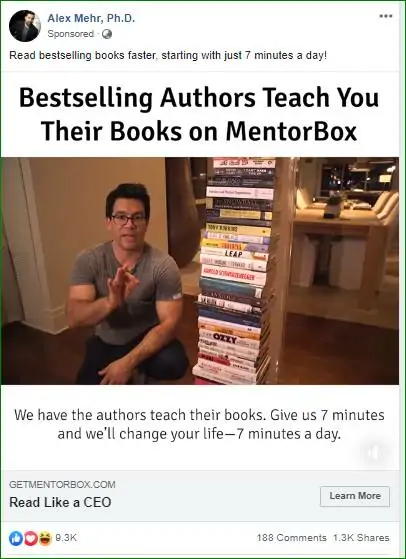
Here are a few things the marketers did well:
• Speaks to the target audience’s pain points and desires: This ad appeals to people who want to succeed (and would want to be a CEO someday or change their life for the better). It catches the attention of those who turn to books for learnings and inspiration, but feel like they don’t have the time to read.
• Using video to supplement the message: One of the first things viewers see is a tall stack of books–52, according to the advertisers–which is the number of books an average CEO reads each year.
• Social proof: The ad, in a way, gains social proof by including the words “bestselling books,” “bestselling authors,” and images of well-known books their target audience may have loved to read/purchase but haven’t.
• Clear benefit for users: They promise to change users’ lives in just seven minutes a day. Plus, they can be “taught” by bestselling authors. Facebook users may see this as a low-commitment, high-return exchange.
Unique, Catchy Visuals: Entrepreneur’s Scopio Deal
In a social platform filled with visuals, this image Entrepreneur used in its ad can stop users from infinitely, mindlessly scrolling through their home page.
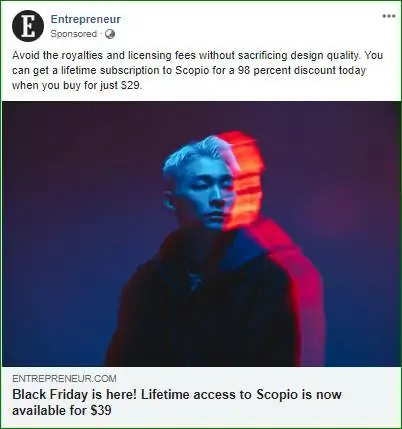
Here are a few components that made this ad effective:
• Unique visuals tied to the product: The image does more than pop out in a sea of images and attract attention. It also gives users a taste of what Scopio, a stock photography library, has to offer.
• Addresses target market’s pain points: Businesses, designers, and marketers, among others, often deal with royalty and licensing fees when they want to use unique images. But this can be tricky for freelancers, small business owners, or even bigger businesses who are hoping to lower their costs. The ad clearly conveys how these dilemmas can be avoided by subscribing to Scopio.
• Clear benefits/offer: The copy clearly shows how much the service costs ($29) and its coverage (i.e., lifetime subscription). It even shows the discount (98%), highlighting the real value of the service users will be getting.
• Encouraging action: Entrepreneur does this by including the words “today,” “now,” and “here.”
The only thing this ad may need to tweak is the $39 price below the image, which may confuse Facebook viewers.
Establishing Trust: Airbnb’s Ad for Hosting
The risk of renters causing property damages is real. Airbnb acknowledges this through their slideshow ad by:
• Clear benefits: Starting the ad with the amount of property protection for hosts (USD$1M). Then the last line of the ad indicates that they can list their place free of charge.
• Speaks directly with the potential host by using “you” and “your.”
• Making the potential host feel cared for and protected through reassuring copy (i.e., “We’ve got you covered” and “Host with peace of mind”).
• Focuses on one action: encourage users to list their property.
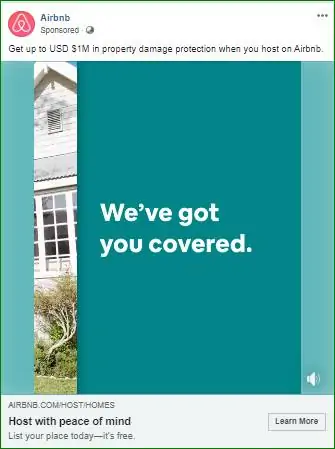
Persuasive Ad Copy and Video: Mindvalley’s FREE Masterclass
This sponsored Facebook ad combines the power of a long copy with an equally convincing video. But note that when the ad shows up in Facebook users’ news feed, users won’t be able to read the entire copy. So what can make them stop scrolling and play the video?
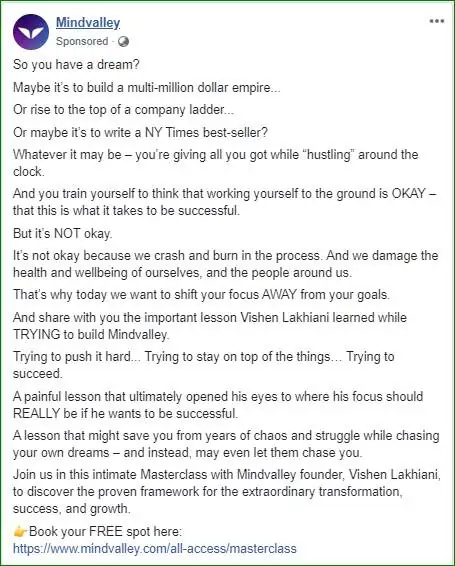
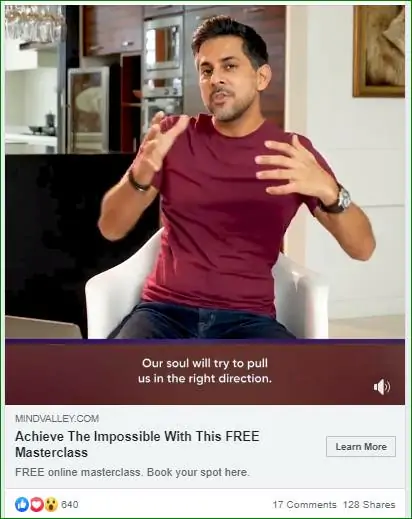
Notice how the ad hooks audiences within the first four lines: the dreamers and the striving entrepreneurs, company employees, and writers. Here are a few more things this ad used to capture interest:
• Establishing trust/rapport: The ad enumerates what its target audience may be going through such as working long hours, burnout, and how these hurt their health and relationships. In doing this, advertisers are able to say: “We know what you are going through.”
• Offers a glimpse of benefits for users: The ad promises to show, through the Masterclass, another way of doing things which will still ensure their target audiences’ success.
• Emphasis on other benefits: Notice that the word “FREE” is kept in all caps throughout the ad.
• Focus on one action: The ad’s main goal is to get people to sign up for the free masterclass. Links are provided within the copy AND at the bottom of the video, which users can easily click whether after reading the long copy or watching the video.
• Leveraging video: Aside from having persuasive copy, the ad also includes a video. Notice how visually uncluttered the video looks. There are no striking colors around the speaker, and the background for the subtitles closely matches the speaker’s shirt. The choice of background music supports the message, creating a peaceful vibe, without drowning out the speaker’s voice.
Focusing on Career Advancement and Quick Learning: Udacity’s Ad
Udacity’s Facebook ad also conveys several key messages with very few words.
• Limiting colors: Both images used almost the same colors. It also used colors to highlight two programming languages users can learn.
• Addresses fears: Today, many would like to future-proof their careers. Others wanted to shift but may be afraid it would take such a long time to acquire new skills. Udacity addresses both concerns by emphasizing users can learn the skills in just four months. They can use these newly acquired tools to move to their dream job or to “upgrade their career.”
Final Words
There are a lot more examples of effective ads that can inspire you as you brainstorm for your first or next Facebook ad campaign. You can always create your own compilation of amazing ads and list down what you think made each one effective.
Even as you are planning your next campaign, be sure to start using a Pixel so you already start gathering data about your visitors. Also, look at your data from previous or current campaigns and see if you can carry out retargeting campaigns.
If you are running your campaign but not seeing the results you want, follow the steps in this guide to split-test your ads. Remember that the successful campaigns you hear about are not merely products of luck, but are the results of careful planning, observation, audience/buyer research, execution, experimentation, and continuous improvement. And these are strategies you can always duplicate or learn from to increase your conversions.
